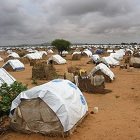This map layer shows the forecasted proportion of population by country which will be living in flat coastal regions (0–10m) in 2030 and therefore will be affected by the consequences of rising sea levels.
Coastal regions all over the world stand out for having a higher than average population density—and a similarly higher growth in population compared to inland areas. Significant reasons for this are, firstly, rapid economic growth in urban coastal areas as well as the accompanying migration from inland areas.
Current studies forecast a rise in sea level of 0.3 up to a maximum of 1 metre for the year 2100. Just under two-thirds of the rise will be able to be traced back to the thermal expansion of water, the rest of it to the influx of melting waters from the mainland. Even if the rise cannot be exactly predicted due to the many uncertainties and differing influencing factors, it is nonetheless probable that it will have severe consequences for ecosystems and inhabitants of coastal regions. On the one hand, among the consequences are coastal erosion, salinization of coastal waters and flooding; on the other the potential increase of devastating natural disasters such as for example, tropical storms.
The regions which the data in the map refer to are so-called low-elevation coastal zones (LECZ), generally defined as coastal regions which are lower than 10m. The base year for the LECZ area is 2000—possible changes to the area in the course of a rise in sea level up to 2063 were not taken into consideration. For the population forecast for 2060, different national growth rates between urban and rural areas as well as between coastal and inland areas were taken into account. Furthermore, the forecasts for four different socio-economic scenarios were calculated, whereby the data shown assume a mid-level population growth in the industrial nations and a high rate of growth in the less developed countries.






